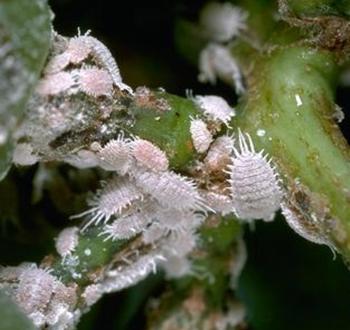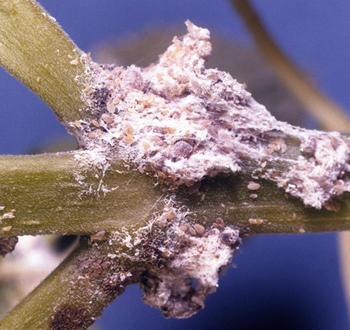Mealybugs in the landscape
-
Jane Scurich
-
Have you ever encountered a white cottony mass on a garden plant and wondered what it is and what to do about it? Chances are the culprit is the mealybug. While more than 170 species of mealybugs exist in CA, very few have become major pests. Some are specific to plants such as citrus mealybug, grape mealybug, and vine mealybug. Some others are simply opportunists.
 Mealybugs are attracted to varieties of succulents and make their home in stem crevices or in and under leaves of rosettes. Photo: UC Regents
Mealybugs are attracted to varieties of succulents and make their home in stem crevices or in and under leaves of rosettes. Photo: UC RegentsThese soft, oval, wax-covered insects usually live in colonies and tend to hide in protected areas such as on stems near the soil, in branch crotches, or in the crown of a plant. Mealybugs thrive in warm climates. A few mealybug species feed on roots. Female mealybugs lay hundreds of eggs on leaves, fruit, and twigs several times a year, leading to rapid colony expansion.
Mealybugs may be confused with other soft-bodied insects, such as soft scale and aphids, as they exhibit similar tell-tale waste. These insects all rely on a sucking process to extract rich sap from the plant phloem (plant vascular tissue that conducts food made in the leaves during photosynthesis to other parts of the plant.) They excrete honeydew. Large populations of these insects can create an abundance of honeydew that drips from plant to plant and onto any available surface. The honeydew can then attract the growth of sooty mold, which attracts ants that become protectors of their sweet treat providers.
Mealybug damage is only sometimes readily seen and may be active in your garden long before you notice. Plants may exhibit decreasing vigor and slow growth, and leaves may fall. Close examination may disclose a little white fluff, like a bit of a cotton ball, on a variety of landscape plants. Take time to inspect it closer. Gently peel back the succulent leaves and examine the stems of a grass at the base and the crook of a tree. Don’t be surprised to find a colony of tiny white pests, almost individually undefinable without the help of a magnifying glass. Healthy plants may not exhibit damage unless the colony greatly expands.
Fortunately, mealybugs have many natural predators, including lady beetles, brown and green lacewings, spiders, pirate bugs, and larvae of predaceous midges. Their spread is not rapid as the female can’t fly, and the nymphs crawl very slowly.
The beetle Cryptolaemus montrouzieri, also known as the mealybug destroyer, is the most important of these predators. Still, it does not tolerate cold winters and may not survive in our climate.
If you have a history of mealybug infestation in your garden, consider limiting plants known to appeal to the bugs for a year or two and remove infested plants where mealybugs have resisted treatment. Many common landscape woody ornamentals and some herbaceous perennials, including cactus, coral bells, figs, flax grasses (Phormium), fuchsia, gardenia, hibiscus, jasmine, mimosa, Miscanthus grasses, and oleander may attract mealybugs. A large colony of mealybugs are feasting on a coleus stem. Photo: Creative Commons
A large colony of mealybugs are feasting on a coleus stem. Photo: Creative CommonsMealybugs often arrive in your garden on new plants, tools, or pots. Carefully examine your acquisitions before placing them in your landscape. Remove and destroy any visible mealybugs. Home remedies include hand-picking and destroying the insects, blasting a high-pressure stream of water on sturdy plants where the insects are visible, or pruning them out. Also, consider removing highly infested plants as well as any infected soil. Garden insecticides are not very effective on mealybugs. Their waxy coatings repel insecticides, and their habit of establishing colonies in hidden locations makes them very hard to reach. Insecticidal soaps, horticultural oils, neem oil, or a direct spray of a 10-25% solution of isopropyl alcohol may have some effect on nymphs prior to the growth of their waxy coating. Avoid adding nitrogen fertilizer as the insects may be attracted to new growth.
Neonicotinoid products and pyrethroids may have some effect on mealybugs, but their negative impact on natural predators and pollinators far outweighs their possible benefits.


